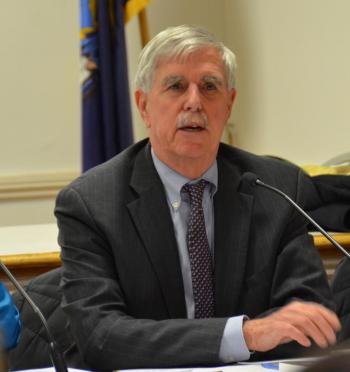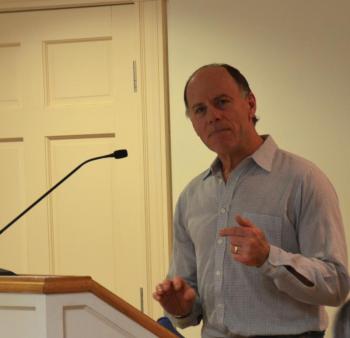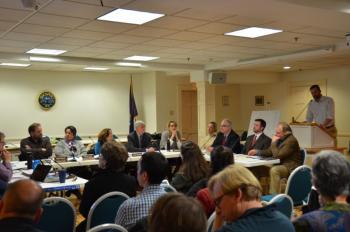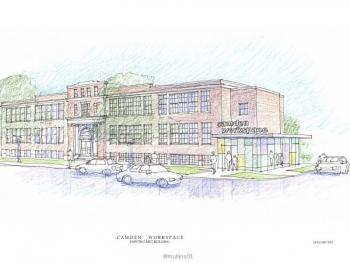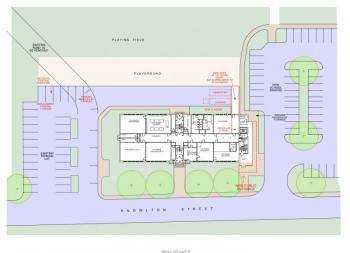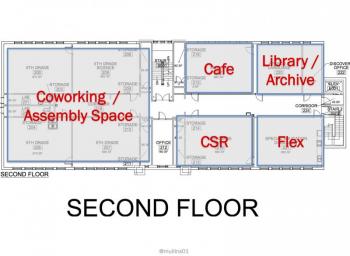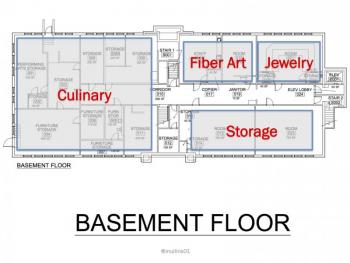Camden-Rockport School board opposes selling MET, warms to leasing the building
ROCKPORT — The Camden-Rockport School Board unanimously rejected a proposal to sell the Mary E. Taylor school for an adaptive reuse project. But in the same amended motion, the board also agreed to continue discussing with the proposal author, Michael Mullins, about alternative options, such as leasing MET to him for his renovation and programs. Tied up in the associated conversation will be the idea of securing space in the renovated MET for school district administrative offices.
“My reaction is mixed,” said Mullins, following the two-hour school board meeting, which filled the Geoffrey C. Parker Community Meeting Room Jan. 10 with approximately 40 citizens, plus board members, two attorneys and two architects, and drew 170 more to watch it streaming and archived online. (Click here to watch it in entirety, and/or watch the attached edited version courtesy Josh Gerritsen)
“Maria [Maria Libby, SAD 28 School Superintendent] just came over and spoke to me, and she said she will be in touch,” he said. “Hopefully she and I will have a conversation. If nothing comes of it, I will be disappointed.”
The school district has vacillated since last summer on the idea of using the MET building for administrative offices. In July, when the school board indicated it might be willing to keep MET standing — if the right proposal came along from a third party — but only if half of the building space would be dedicated to SAD 28 offices.
Then, the parameters changed and the district said in its invitation for MET proposals that it did not want to situate administrative offices there.
That position held up until just three weeks ago, when Mullins met with Superintendent Maria Libby, Board Chairman Matt Dailey and SAD 28 attorney William Stockmeyer, of Drummond Woodsum. They gave a list of questions for Mullins to address at the Jan. 10 meeting, and at the same time, they wanted Mullins to clarify that he was not leasing space from the district.
Mullins said after the Jan. 10 meeting that he would be willing to discuss the possibility of leasing the building from the district.
Libby also said after the meeting that the SAD 28 school board would be further discussing the Mullins project, and would be reaching out to Mullins.
By meeting’s end at 8 p.m., long after Mullins had delivered a full presentation of his proposal, after 15 citizens got up and urged the board to move forward with the proposal, and after 45 minutes of intra-board deliberations and consultations with its Drummond Woodsum attorneys and Oak Point architects, the school board members each began stating their personal thoughts for the record.
As they did, the prevailing opinion was not to sell the building, but at the same time, not to shut the door on alternative options that could emerge from future conversations with Mullins.
Both board members Elizabeth Noble, of Camden, and Carole Gartley, of Rockport, said they opposed shutting the door on future negotiations with Mullins.
“We should continue the discussion, keeping in mind that it cannot affect the timeline [of building a new school],” said Noble. “That’s a deal-breaker. The primary importance is the education and the building of the school. But I’m not willing to shut the door just yet.”
“I’m not willing to shut the door on your proposal, either,” said board member Carole Gartley. “I appreciate your creativity, your expertise. Your presentation was impressive and I would like to explore how we could collaborate, maybe with the district using some of that space, because we know that the district needs administrative space and we’d be looking down the road at building another building for administrative uses.
“I would like to explore working with Mr. Mullins on this project a little more. However, I am not interested in stopping the new construction process. It’s not good for the district financially, or our taxpayers. So, I’d like to keep the door open, and talk with Mr. Mullins about other options, and seeing how we can make it work for both of us, to keep the MET building, meet our needs with administrative offices, the Zenith program, adult ed program.”
The ending deliberations illustrated a divide on the board about the future of MET and plans for repurposing it.
History of the Mullins’ Proposal
Michael Mullins, who is president of the Boston-based Mullins Management, Inc., submitted his proposal via email to School Administrative District 28 Board Chairman Matt Dailey and Superintendent Maria Libby by Nov. 30, 2017 deadline that the SAD 28 school board had set for receiving proposals to keep MET from being demolished with the rest of the existing Camden-Rockport Middle School complex on Knowlton Street.
(Read: Real estate developer submits proposal to repurpose Camden's Mary E. Taylor school)
The $26.2 million new middle school project involves tearing down existing buildings, including the 1925-built MET, and building a new school on the same property.
Public outcry concerning the demolition of MET persuaded the school board to entertain alternative proposals, and Mullins produced one by deadline.
Mullins had been alerted to the Camden-Rockport debate over the future of the MET building via a friend on Facebook. Mullins, who developed a Rockland quarry property, and has focused his business on developing old mill real estate in Massachusetts, in addition to his growing personal interest in entrepreneurial education and programs, saw an opportunity in the pending vacancy of MET.
Mullins envisions an adaptive reuse of the 1925-brick-built MET for educational and mix-used purposes.
The meeting had, in some ways, culminated months of debate in the Camden-Rockport community about the fate of the 1925-built brick MET building on Knowlton Street.
While the school board had tasked itself with considering Mullins’ proposal Jan. 10, instead of approving the proposal, which would keep MET from the wrecking ball, or opposing the proposal altogether, which would reinforce the plan to demolish the building, the board has now reintroduced the possibility of keeping the building standing, albeit with an inconclusive plan.
“I think this is what people need to hear,’ said Gartley. “That this isn’t the end of the discussion of the MET building.”
How the board voted
School board Chairman Matt Dailey made a motion that “the Mullins proposal be declined and the Superintendent formally notify Mr. Mullins of this decision.”
Vice Chair Lynda Chilton, of Rockport, who was acting as chair, asked for a second, which was made, and then opened the floor for additional discussion.
“If this motion passes, I still would encourage the superintendent and the board to reach out and try to come up with another way of incorporating this proposal, idea, into the building,” said board member Peter Orne, of Camden.
“I agree,” said Gartley.
“I wonder if you would like to get Matt to amend his motion,” said Marcia Dietrich, of Rockport.
Dailey declined to amend his motion.
“We will keep this clean and then we can move forward at subsequent meetings as to what we want to do,” he said.
Gartley then asked about the process of amending a motion.
“Any one of you can move to amend the motion,” said Attorney William Stockmeyer.
Dietrich then moved to amend Dailey’s motion to allow the district to “continue discussing other options with Mr. Mullins that might be in the district’s interests.”
That amendment was seconded and Chilton called for a vote.
The vote was 6 to 2 in favor of the amendment, with Chilton and Dailey opposing the amendment.
The board then voted unanimously to approve the amended motion.
The motion was then reread by Kimberly Ward, executive assistant to the superintendent.
“The first half of the original motion was that the Mullins proposal be declined and that the superintendent formally notify Mr. Mullins of the decision,” she said. “Marcia moved to amend the motion to allow the district to continue discussions with Mr. Mullins in regards to additional use of the MET building.”
At that point, Superintendent Libby said: “The actual motion would be that ‘I move that the Mullins proposal be declined and that the superintendent be allowed to continue conversations with Mr. Mullins.”
Attorney Spencer then said: “You missed the part on formally notifying Mr. Mullins.”
The Mullins vision
Michael Mullins spoke for approximately 20 minutes, outlining of his personal background, and the details of his proposal (See attached PDFs for the full proposal submitted Nov. 30 and then his Power Point presentation Jan. 10).
He spoke of his entrepreneurial education, which includes the MIT Center for Real Estate, University of Miami School of Business, and the University of Chicago Booth School of Business, as well as training with the international Startup Leadership Program. Mullins also said he works in New Urbanism, an development approach that promotes walkable streets, housing and shopping in close proximity and “human-scaled urban design,” according to the Congress for New Urbanism.
He cited his 72-acre, 220-unit mixed use, village style development in Winslow, which was submitted to the Winslow Planning Board in 2016, and currently remains on the review table waiting for more architectural information, according to the Winslow code enforcement office.
In Camden, Mullins wants to create a “semi-profit organization,” a low-profit corporation that would be based on a membership program to financially sustain it.
Members would have access to the programs in the wood shop, metal shop, co-working space, culinary kitchen and fiber arts space.
“In addition, we would do some educational programs,” he said for adults and children, to get “kids to think away from the disposal consumer economy and more towards how things work.”
The workspace, he said, would include a repair cafe where “experts who know how to fix stuff together” and anyone can take their vacuum cleaner or any other component over to do it.
Mullins cited “lateral learning,” as the driving concept of his proposal.
“People have said, why do this project? We have The Apprenticeshop in Rockland, the metal workshop facility. We have the woodworking craftsmanship over on Route 90. Why do you do this?’ My answer is that we are going to create a special dynamic by bringing all these together.”
Later in the meeting, in response to a question from board chairman Matt Dailey that referenced possible competition with the Midcoast School of Technology – “and ourselves” — in Rockland, Mullins said the workspace is extra-curricular. The scuttlebutt, he said, “is we need more kitchen and shop space, and getting people assembled.”
He said bringing together different types of knowledge, and teams, creates dynamic entrepreneurial energy, which in turn, enhances economic development for the region.
“You need a place to bring these together where those types of connections are made,” he said.
He said his plan depends on volunteers, and its governance would include a board of directors of local people and stakeholders.
He said he would be the executive director and he would hire a part-time manager.
Finances
Mullins likened his model to that of Planet Fitness — low cost basic membership, no frills.
His goal is to have a membership “in the hundreds” and he would seek sponsorships and contributions from local businesses. He said: “I’m going to make personal contribution and line of credit to close on the building.”
Mullins said he wants to make the workspace affordable with “lots of tradespeople, people coming in.”
Annual memberships would range in price from $19.95 for adults on weekends only to $99.95 for unlimited shop usage.
Coworking prices would be $99.95, and $149.95 for those with a dedicated desk.
The pricing for youth memberships range from $9.95 to $49.95.
He scheduled a three-year ramp-up period, with 2018 being customer development and financing to 2020, with building of studios and shops, to 2020 and beyond for development of specialty program modules.
The scope of physical plant work for Year 2020, when MET becomes vacant, would entail installing a pellet-fired boiler using exist hydronic heat, remove select partitions, and construct entry vestibule and loading area (see renderings).
Public comments
Just before members of the public rose to deliver their opinions and ask questions, board member Carole Gartley asked for clarification on whether the comments heard would be limited to just those who live in Camden or Rockport.
Vice Chair Chilton said at the Dec. 20 meeting, the board “kept it to Camden and Rockport.”
Superintendent Libby said that was consistent with the district’s public participation guide.
Camden resident Jane Lafleur said she was intrigued by the idea, and liked the idea of saving MET. She encouraged the board to take the proposal seriously, and that it would serve to attract young people to the area.
“I'm excited,” said Camden resident Patrick McCafferty. “I have three sons in SAD 28.”
He said he owned a Camden masonry company.
“We gripe about not having enough people to take over. Being in masonry, I'd love a particular hub... to encourage kids in trades. I'm here to voice support.”
He said he would contribute up to $2,000 of his business profit to the workspace to help stimulate interest in masonry.
Camden resident Lowrie Sargent said the town has spent a lot of time considering how to develop space for young people.
He said that rather than “tear down and throw away, this is great idea for adaptive use.”
Additionally, if the board accepted, the district would, “not have to spend money on restoration and site reconfiguration.”
Then, he asked, could the money saved be used to reduce the amount of the bond: “or will that money be put that back into budget? Money is tight and everybody is concerned about cost.”
Camden resident Chris Fasoldt said: “This is a wonderful project, preserving the building for ed purposes. It is sort of like the perfect idea for the building, and I also could use the shop.”
Anita Brosius-Scott, of Camden, said: “This is a great opportunity to enhance economic development of town, a way to grow the creative aspect of trades and is our greatest strength. This fills a hole we didn't know we had: opportunities to young people and old, and grow the economy.”
“It is a great idea,” said Camden resident Robin McIntosh, encouraging the board to continue the conversation.
Camden, she said, has had conversations about how to expand economic activity, coworking space and encourage conferences.”
Barbara Lawrence, of Camden, called the proposal brilliant.
“I hope you support it,” she said.
Mike Sabatini, of Rockport, characterized the proposal as excellent.
“It would save MET, my biggest concern,” he said. “I would ask the board to think long and hard of divesting the building. You’re going to need space”
“This building has such character and opportunity to remain a viable structure in town,” said Camden resident Michael Skaling. “It is a good proposal and what an opportunity for mentorships. It is a travesty to tear this building down. It’s there, it’ a beautiful building. let’s keep it.”
Board deliberations
As the board continued to review Mullins’ proposal, board member Dietrich asked him if he would be interested in a lease at a nominal cost.
“Yes, I would, if it made sense,” he said.
He would forego the historic tax credits financing, and would “have to think about the length of the lease and exit strategy.”
Toward the end of the discussion, after conversations that touched on the legalities of Mullins owning the building but the not land, the possibility of getting the Town of Camden involved, building restrictions, the possible need to return to the voters to ask for approval to sell the building, and the specifics of leasing.
Both board members Orne and Gartley then turned to the topic of collaborating with the school district and allowing it to use part of the building for office space.
“Would you be open to collaborating with the district and having admin offices, and lease a portion of the premises?” she asked.
Mullins replied that such a concept could materialize with two options:
1) Lease the whole thing and rent offices; and
2) lease two thirds from the district.
He deferred to Attorney Stockmeyer, who said the statute is remarkably opaque”iopaque on the issue of leasing timeframes, and said he would want to investigate further the specifics of the law governing leasing buildings and property.
He also mentioned that if the town of Camden were involved, and owned the building, the laws would be different.
Orne asked Attorney Stockmeyer if there was a legal vehicle that would allow the sale of the property and if, down the road, the ownership was to change, or use changed, then the building would revert back to the original owner.
“Those things can usually be accomplished,” said Stockmeyer.
Gartley asked how many memberships and investors the workspace would require, and the venture’s cash flow.
Mullins said the venture, if private, would be subject to $5,000 to $10,000 annually in property taxes.
The sustainable revenue for the venture is $60,000 annually, he said.
Capital costs to close the deal and restore services would cost $300,000, and then another $50,000 would be needed for the pellet stove.
“I feel pretty good about it,” he said.
Board member Noble asked Mullins why he did not take the nonprofit approach.
“I’m sort of a newcomer to the area,” he said. “I don’t have the network to solicit $400,000 in donations to make it happen.”
He said he would review rules for crowdfunding for the workspace. He also said if someone wanted to step up, he would consider a nonprofit.
“For me, this is not a money making venture, per se, I’m just trying to find a way to save the building, and do it in a way that intrigues me,” he said.
Chilton asked how the proposal would affect the costs of building a new school, as well as affecting the construction timeline.
Architect Tyler Barter said engineers may have to be consulted for additional calculations because the site plan was drawn with MET torn down. The formula for allowable impervious area on the site site may already be at capacity, with MET demolished and a playing field in its place.
He projected a possible nine-month delay and additional engineering costs.
His colleague, Rob Tillotson, who is president of Oak Point, based in Biddeford, said construction costs could increase with the possible delay.
In the end, all board members said they would not give up the current timeline for constructing a new middle school.
They all said, however, that they liked Mullins’ ideas.
Chilton said while the ideas were interesting, the board’s main focus is on students, teachers and education.
“We are elected to run schools and do best for the kids,” she said. “Were are not in the business of economic development, historic preservation. These are all very interesting ideas but what are best things for kids at the middle school?”
She said green space and playing fields were important to kids, as well.
“I think the proposal in the abstract is a good job,” said Dailey. “Ultimately, I am concerned with timeline and exciting as it sounds, considering the possible impact, I don’t think I can support it.”
Orne said that while Mullins has vision and is a thinker, he believes the district needs the building. He said he was not in favor of proposal, he was in favor of exploring a lease-back.
“I’m not comfortable shutting the door on this,” said Noble. “There is a lot to explore.”
She also said that she was against negatively affecting the new school construction timeline.
Chilton said she was concerned about continuing the conversation about selling the building, although she would not oppose talking about the MET building in the future.
Gartley then said she was glad Chilton had clarified that she was against the proposal for purchase but not the general conversation about MET.
Dailey said the superintendent did not have time to continue discussing the proposal.
“This isn’t the end of the discussion for the MET building, but this particular solution,” he said.
If the board decides to continue these discussions it should be thinking about a referendum and associated costs on the building new project, said Stockmeyer.
In the end, the board began crafting its motion and referendum, and after voting, the meeting closed, although many stuck around for continued conversations in small groups.
Related stories
Camden-Rockport School Board to discuss MET repurposing proposal Jan. 10
Real estate developer submits proposal to repurpose Camden's Mary E. Taylor school
SAD 28 chairman tells Rockport Select Board member to step off school Building Committee
Citizens appeal to Camden, Rockport select boards about school bond process
Camden Planning Board chairman recuses himself from new school review
Camden Planning Board consider zoning changes to accommodate new middle school height
Heating Camden's new middle school from town's sewer plant: What's the cost and can it be done?
Owner's representative hired for new Camden-Rockport Middle School construction
Give community a chance to brainstorm about MET before tear-down, citizens tell school board
Camden Select Board hopes to meet with school board Thursday evening over MET future
Future of Camden's MET building to be discussed at two board meetings, municipal and school
Maria Libby on middle school project planning and Mary E. Taylor School
Camden-Rockport Middle School building project forum tonight
The future of Camden's Mary E. Taylor School. Tear it down? Lease it to another entity?
$28 million Camden-Rockport Middle School project proceeds to vote
Opinion: Camden Rockport Middle School project examined
Letter to the editor: School board responds to Camden Planning Board project concerns
Camden Planning concerns about middle school project
Camden-Rockport leaders skeptical of $28 million middle school project
Read about the March 20 forum: Camden-Rockport board endorses public straw vote: Tear down, rebuild middle school
What to do with Camden-Rockport Middle School: Tear down, renovate, rebuild?
Camden-Rockport Middle School concepts floated: ‘Everything in pencil’
Editorial Director Lynda Clancy can be reached at lyndaclancy@penbaypilot.com; 207-706-6657



